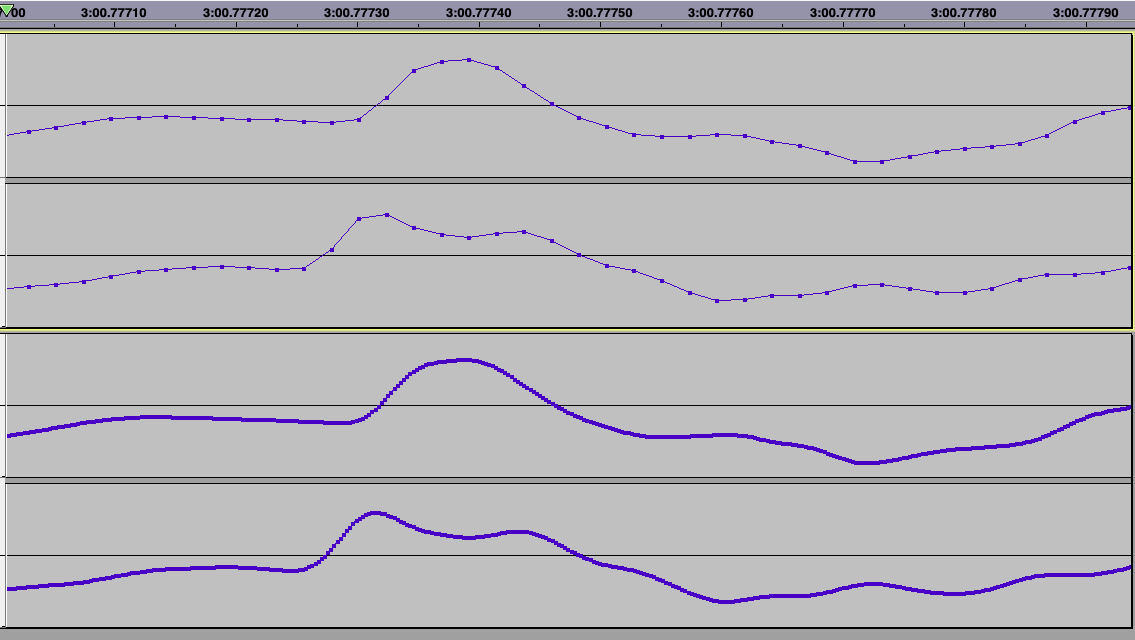The process is much more random than you think.
What I think is irrelevant, it's what the science proves/demonstrates that's important here and what it proves is that it is NOT random.
The dispatching of the elementary sinewaves in the time domain in totally random. This is the reason why you can always have information between two samples, even though the elementary components are band limited.
I have no idea what you mean by the "dispatching of the elementary sinewaves in the time-domain". There are no "elementary sinewaves in the time-domain" unless you're reproducing nothing but a single sine wave.
What we sample is not sinewaves but the surface of the waveform.
No, what we sample is the amplitude of the waveform.
If you don't sample this surface with a very high precision, then the reproduction of the sinewaves that are inside is distorted.
Now you are contradicting yourself again. In another thread you repeatedly state how good DSD is but DSD has just one bit resolution, the very lowest precision that's possible in digital audio! So which is it, do you need very high precision, in which case DSD must be absolutely terrible or is your statement above false?
We need to be aware that the AD converter doesnt have any access to the content of the waveform.
Of course it has access to the content of the waveform. If it has no access to the content of the waveform then what do you think a converter is converting? Even by your own incorrect definition of "what we sample", isn't this "surface of the waveform" part of the content of the waveform?
What is under the waveform is band limited, but the surface is not.
There is no under or surface, there's just the waveform and a waveform is either band limited or it's not, it cannot be both at the same time.
We generally admit that people older than 30 cannot hear anyting above 16 KHz. Then we could sample a good analogue master on tape at a sample rate of 32 Khz and see if it sounds as good as 44.1 KHz.
Not sure what you mean by "we could" because science and engineers have already done that. In fact it was standard practice in some parts of the audio industry at one time, so it's probably been done millions of times! Although under controlled test conditions probably only a few thousand times or so.
We can also try to interprete the sonic results achieved with DSD.
Why do we need to interpret the sonic results achieved with DSD when we can precisely measure the sonic results objectively.
This technique is very different from PCM and the sound depends a lot on the analogue filtering after the bitstream
No, it's very similar to PCM and one of the main points of DSD was to reduce the quality requirements of the analogue filtering. So again, pretty much the exact opposite of what you're falsely stating!
We need to understand that the waveform is the product of a mathematical function.
Why do we need to understand a statement that is false?
Auditions do confirm my theory.
No they don't. Controlled tests demonstrate no one can tell the difference, in some sighted tests the subjects can't tell the difference and in some they can but even these cases do NOT confirm your theory! What subsquent controlled testing confirms is the theory of placebo effect.
People who have learnt the basics of traditional digital audio generally consider for certain that a sample rate above 48 KHz cannot benefit to sound reproduction and they are submited to a nocebo effect because hearing the difference would lead them to reconsider what they learnt and this often makes them uncomfortable.
Which is why we haven't only tested scientists and audio engineers but also the public, audiophiles and students who have no knowledge of the basics of digital audio. The results are the same!
High resolutions audio formats are becoming more and more successful, with offerings from Apple, Qobuz, Amazon and Tidal. The people who are ready to pay a premium price for them are expected to hear the benefit they bring to the sound. Why would they pay more for they same sound quality ?
Isn't that obvious? If marketing can convince them that the sound quality is better (even though it isn't) people will pay more. A very large part of the audiophile world is entirely based on this fact! Did you not know that?
G






















